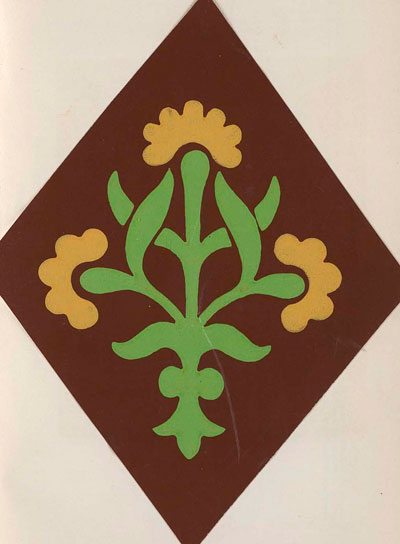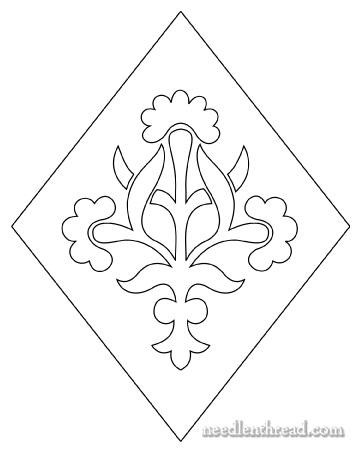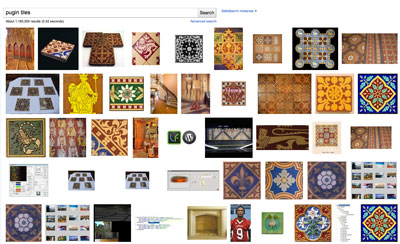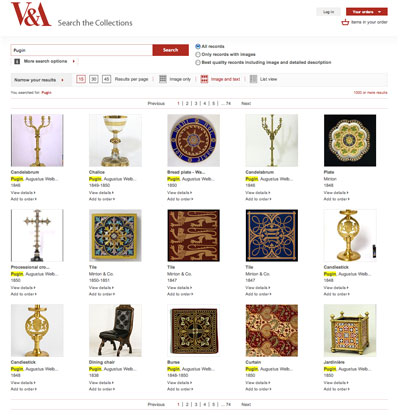Where do you find inspiration for your embroidery projects? I suppose inspiration can really be found anywhere, but I like to look at other textile designs, wallpaper designs, tile designs, wrought iron designs, and on and on and on.
One of my favorite artists (actually, an architect) from the past – Augustus Pugin – happened to leave behind a massive legacy of textile, wallpaper, tile, and all kinds of “decorator” items that are suitable for adaptation to embroidery. I especially like looking at Pugin’s tile designs, but his wallpaper patterns, stained glass, furniture, textiles, and metal work all give plenty of play room for the imagination, when thinking in terms of embroidery design.

You can squiz the internet for Pugin’s work and come up with myriad photos that display mostly bold colors and deep contrasts in design – with relatively simple lines. Because I was looking for a very simple pattern that could demonstrate darned fillings (running stitch worked into patterned fillings), I turned to right away to Pugin. Among the places to which I ventured was The Textile Blog, which is a great informational blog on All Things Textile. I came across the image above, which is one of Pugin’s wallpaper diaper designs.
I converted the design to a line drawing, which was a really simple process, thanks to the simplicity of the design and the contrast in color.

As a line drawing, you can see that the design does indeed make a simple pattern – but a good pattern for embroidery that might involved voided areas and a patterned background, or patterned areas and a voided background. Once I started looking at the design as a line drawing, Colbert embroidery jumped into my mind. What about whitework or pulled thread embroidery? They’d work, too. The design is completely adaptable to all kinds of uses.
If you like this kind of design and can see how it could be used for your own needlework, you might want to look up Mr. Pugin and see how his work inspires you. You can search for Pugin on Flickr and come up with heaps of photos of Pugin pieces. You can also do an image search on Google and come up with plenty of adaptable possibilities.

I searched “Pugin tiles” in Google images and came up with too many pretty things to count!

My favorite Pugin art resource is the Victoria & Albert Museum. If you search the collections at the V&A using “Pugin” as your search term, you’ll hit the jackpot!
Playing with Pugin’s artistic creations is fun, and it really gets the juices flowing if you’re looking for embroidery design ideas.
If you’d like the PDF of the above line drawing, here ’tis:
Pugin Design as an Embroidery Pattern (PDF)
Who (or what) inspires your embroidery?
Looking for inspiration & information on hand embroidery?
There are all kinds of reasons to sign up for the Needle ‘n Thread daily newsletter! Check them out and sign up today!







I’m looking for a nice pattern for Colbert embroidery for a long while. Thank you Mary for sharing this pattern and your source of inspiration.
If you search for Pugin on the Internet Archive (http://www.archive.org/), you will find a lot of wonderful publications. Like this book about Gothic ornamental designs http://www.archive.org/details/cu31924015690781
I love the Art Nouveau period, and particularly Charles Rennie Mackintosh and William Morris. Mackintosh’s stained glass designs with stylised roses translate beautifully into embroidery designs, and Morris designed beautiful embroideries. Thank you for sharing the V&A resource, I particularly like Pugin’s blue Minton tile, so pretty.
I love the simplicity of the design. For me, blackwork popped into my mind when I saw it. The basic design may be simple but what a wonderful way to show off the lacy intricacy of blackwork.
Thank you for sharing this inspiration source. Looking it over on the V&A museum search, I am struck by just how very … medieval and Tudor the designs seem to be. That he recreated a Glastonbury chair and yet it is credited as a Pugin design. And his various lions and Tudor roses with portcullises (Henry VIII’s symbols) just shows that some classic styles repeat themselves over and over in time. That, or folks were heavily inspired by medieval and renaissance designs during his period, just as it continues to inspire people today.
Mary, right now, I am a child setting her toes in the vast ocean that is textile arts and you are one of my inspirations.
My inspiration for my embroidery is eclectic and diverse. I certainly find motivation in my collection of books about fine needlework and decorative arts. I especially enjoy seeing embroidery being used in every day life. For me, even an embroidered dish towel can be a source of visual delight. I adore photographs of embroidered trousseau items from the past, such as lavishly monogrammed sheets and pillowcases. In fact, I must confess to being a little monogram crazy. Embroidery as embellishment on historic costume fascinates me, whether in portraits or photographs of dress for a museum exhibition and I can lose myself for hours. I often say on the phone at least once a day to someone, we need beauty now more than ever, so I do try to visit different sites on line in search of embroidery inspiration. And finally, one of my favorite sources of inspiration is Mary’s blog!
Thank you! I’ve been looking for a source of blackwork designs for a project not unlike the one that Kathy over at the Unbroken Thread did with all the goldwork. I’ll have to take a look at these.
Oooh, a bit too symmetric for my taste, although it is certainly a very versatile design.
I tend to draw my own designs out of my own head, which usually involve lots of swirls and spirals, they may be ispired in style from Tolkien drawings, or from some of his illustrators(Alan Lee), but my best ispirations usually come from nature, especially flowers. Drawing real flowers from life often brings out details completely unexpected,and even if they become stylized or change colour in the embroidery, real flowers are often more fantastic than any imagined ones. My current (experimental) project is a bunch of stumpwork nasturziums.